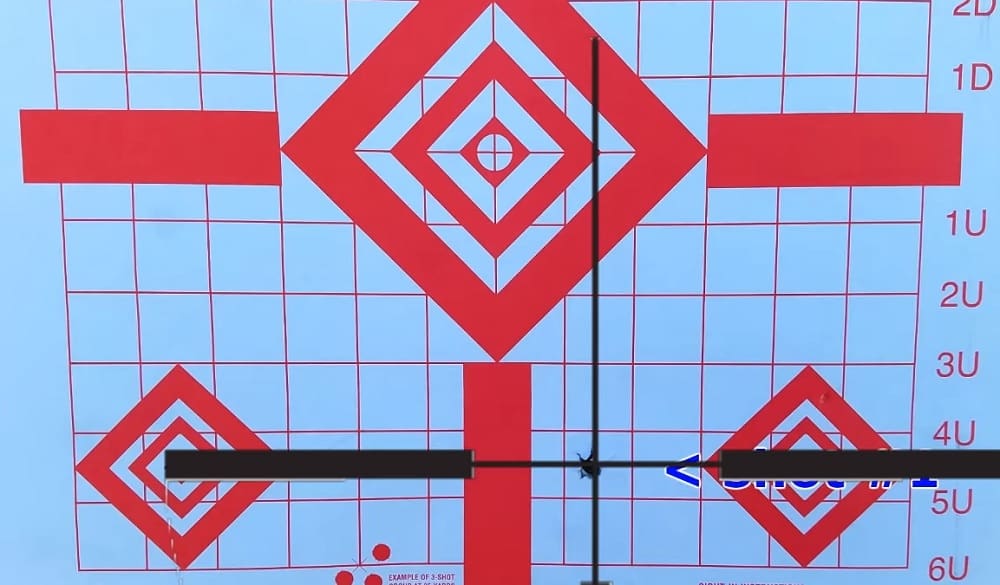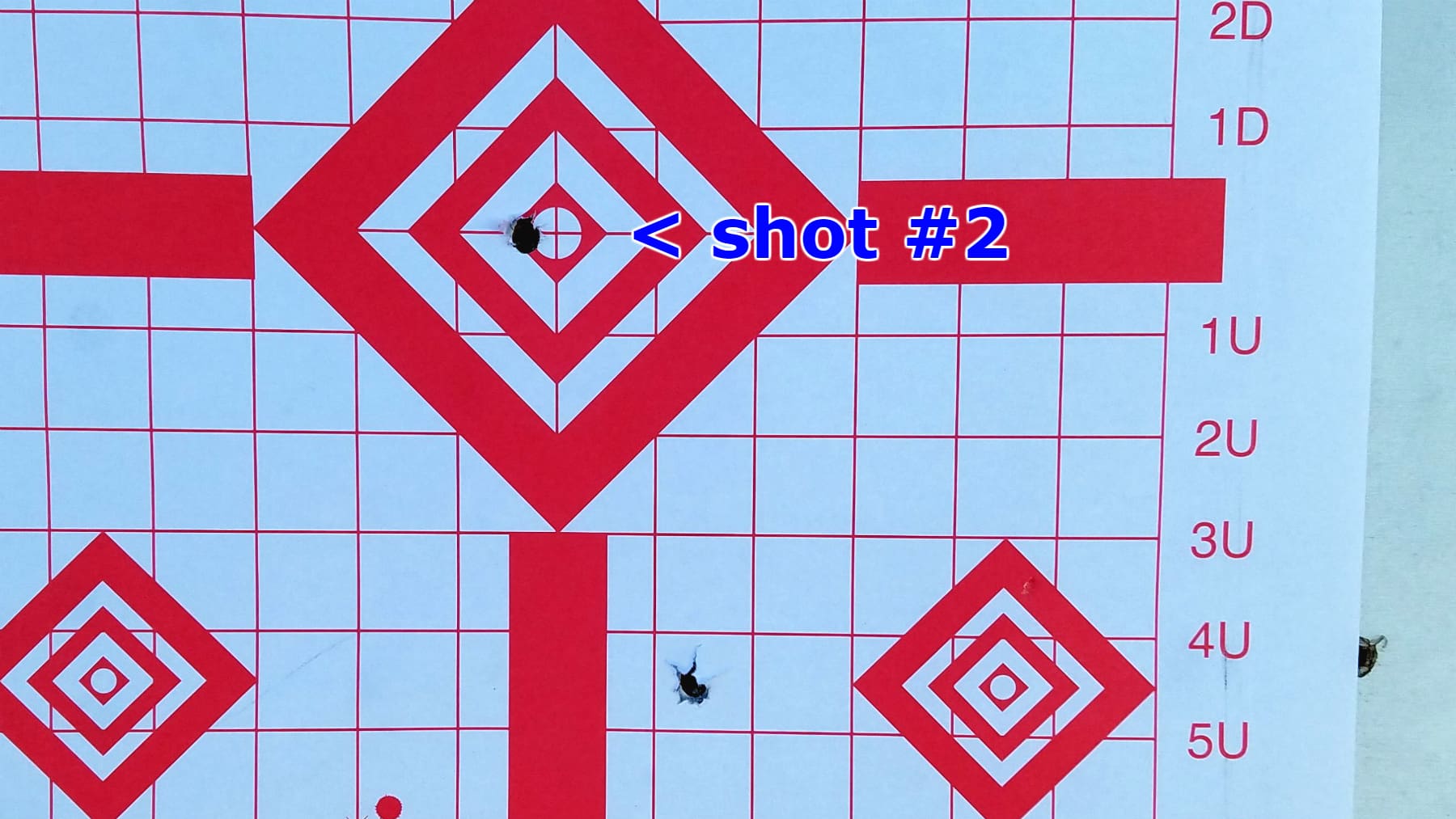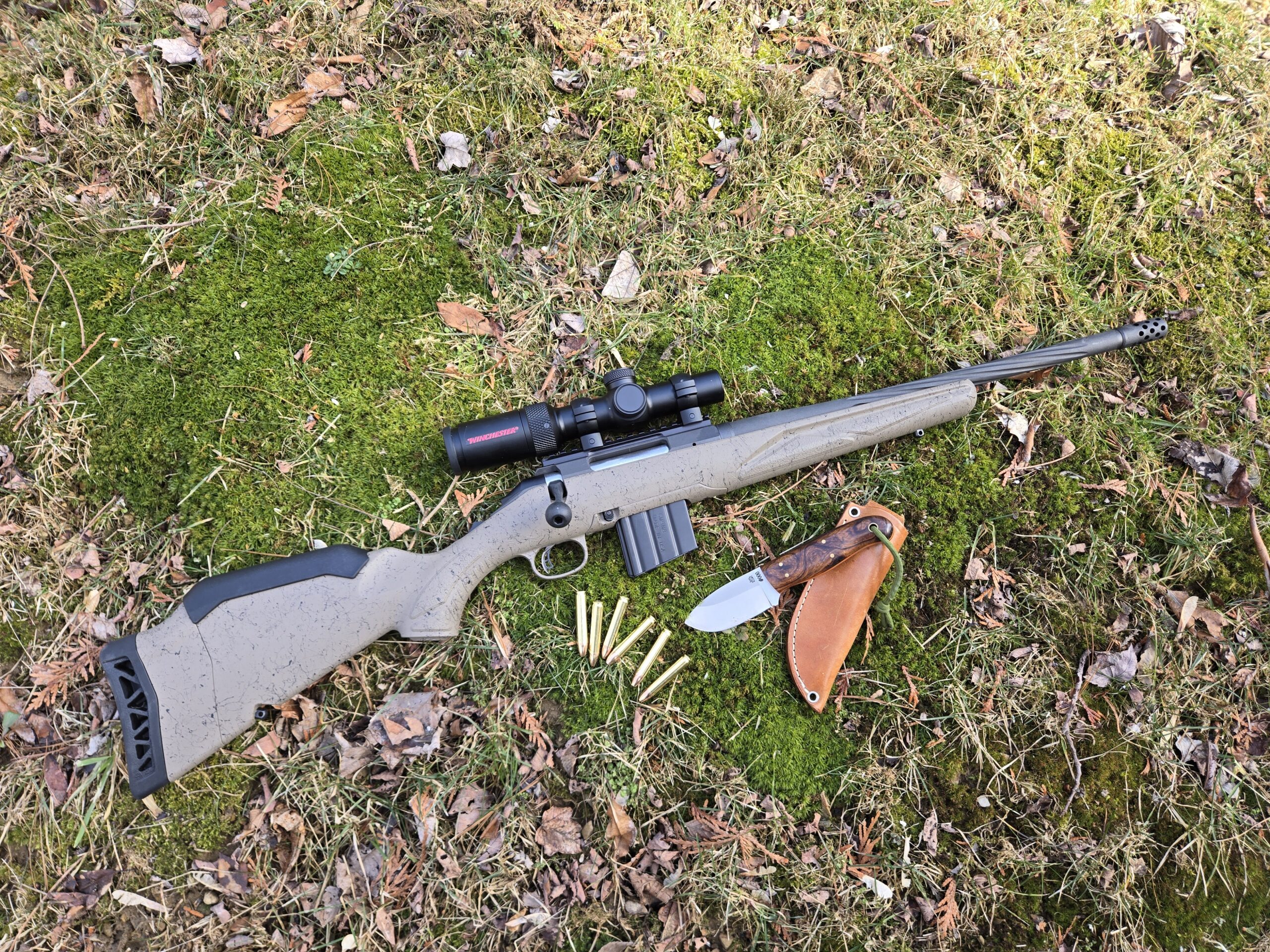https://www.youtube.com/watch?v=lqLumP1XItY
There are few things more frustrating than wasting good ammo trying to get your rifle zeroed. If you just can’t seem to find the paper or can’t chase that zero down, turning expensive ammunition into nothing but noise gets old really fast.
Since I’m constantly bolting optics onto loaner rifles, I thought I’d share how I get zeroed at 100 yards with as few rounds fired as possible.

First and foremost — non-negotiable to this process, actually — is a rock-solid rifle rest. Jon Wayne Taylor and I have gravitated to the Caldwell Stinger this year, but there are many Lead Sled type options and other inexpensive ones that use straps and clamps to keep things stable.
Keep in mind you don’t actually have to shoot from this rest. You need to shoot in as accurate a manner as you and your rifle are capable of, but the rest is only needed for holding the rifle absolutely steady while you’re making adjustments to your optic.

Bore Sighting
Once your scope is properly mounted, your first step is to establish a rough zero. The only goal of this step is to land your first round anywhere at all on the paper.
If you’re shooting a bolt action rifle, remove the bolt. If you’re shooting an AR platform rifle, remove the upper receiver, then remove the bolt carrier.
With the rifle or upper (or whatever assembly contains the barrel and mounted optic) on the rest or otherwise held absolutely as rock steady as physically possible, look right down through the barrel at the target.

The chamber end will appear to be a larger circle and the muzzle end a smaller one. To ensure you’re looking straight down the centerline of the bore, center that smaller muzzle circle in the larger chamber circle.
Adjust your rifle rest set-up until you have the target — again…visible through the barrel — centered in the bore. It’s more difficult to be precise with this if you have a short barrel with a large bore that it is with a long barrel and a small bore, though seeing the target while using the barrel as a zero-magnification telescope is easier. Try to get your eye closer to the chamber if you’re having trouble seeing your target through the barrel.
Once your barrel is on target, it’s time to get your rifle scope on the target, too. Most important: DO NOT MOVE the rifle AT ALL during this process…or it won’t work.
Run the turrets until the reticle is centered on the bullseye. Usually that’s clockwise on the elevation turret to move the reticle up and clockwise on the windage turret to move the reticle right, but knowing which is which doesn’t much matter. Just turn ’em and watch the reticle move and move it to the center of the target.
Move your eye back down, look through the barrel again and confirm that the target is still visible in the center of the bore when you look through it.
Boom. You’re now bore sighted.
Keep in mind this is a [very] rough zero, but is should be more than good enough to get your shot on the paper. You can also use a laser bore sighter to accomplish this, but they can be difficult to spot at 100 yards in daylight. If it’s visible, though, it’s even easier than looking down the bore.

Shooting and adjusting
Get yourself and the rifle stable — remember those fundamentals — and fire a shot. If you know your rifle and ammo combination is extremely accurate and feel confident you made a good shot, one round can suffice. If it’s a new gun or one that puts up a bit of a spread, fire three to five shots to create a group. You’ll use the center of this group for the next step.
Re-adjust the rest (or put the rifle back on it if you weren’t shooting from it) so the reticle is, once again, perfectly centered on the bullseye.

Now, dial the turrets until the crosshair is on your bullet hole (or centered in your shot group).
Congratulations. You’re zeroed!
At least…in theory. You’ve matched up your scope’s point of aim with your rifle’s point of impact, and that’s what this game is really all about. It’s nice to confirm things with another shot(s), though, and do any fine-tuning that may be needed.
You may also want to consider tapping your turrets with a little tool or a round of ammo or something. Not enough to move the rifle at all, of course, but enough to unstick the widgets inside the scope just in case your hardware is old, cheap, etc. Then make sure it’s still centered on that bullet hole.

Bingo! I got lucky when I chose to go through this process on camera for the video above — the confirmation shot was effectively dead-on with this ~1 MOA rifle (which I’d normally give the 5-shot group treatment). “In real life” I’d expect to do a final fine-tuning if I want this rifle and ammo combination to be truly dead-on zeroed.
There you have it: a straightforward, easy zeroing process for jumping right to 100 yards, sighting in, getting your first shot on paper, and zeroing your scope quickly. And all while using as few as one single round of ammo.









“…at least…in theory.”
I simply shoot targets closer and closer to me until I hit something. 200 yds…100 yds…50 yds…25 yds (bam!). Okay, now I know I have to wait until the deer is within 25 yards of me if I want to have a chance of hitting it.
A 36 yard zero should be all anyone really needs.. And no waste of ammo in doing it either.
I believe it is 27 yards is the same zero as 100 yard for most rifles. At that distance one can ignore windage unless it is a gale blowing, the why are you trying to zero your rifle in a gale? You may be a bit high in the 7 ring instead of the X ring with zeroing at 27 yards, but you certainly will be on the paper. I once watched a local swat team trying to zero their $4000 rides and $5000 scopes at 100 yards. After banging away for an hour or better they gave up. Hadn’t gotten a round on the paper in 100 rounds of Federal match .308 which brass I retrieved from the trash after they left. I would have told them how to get on paper and zeroed but they were such a smart ass bunch I let them fruitlessly bang away.
If you have the software you can calculate and print a known range calibration target for a much closer distance. Still need to actually zero but I typically get a few inches from center.
SAFEupstateFML,
Your comment dovetails with what I was going to say:
Wind drift can be surprisingly significant even at 100 yards. That means a 7 mile-per-hour cross-breeze can push your bullet horizontally off target a surprising distance. And if the wind speed is variable, you can end up chasing “zero” around a long time and burn up a lot of ammunition. What I have found is that any reasonable cross-breeze is more-or-less insignificant at 50 yards. Thus, I always sight my firearms in at 50 yards, at least initially.
The missing detail (to sighting your firearm in at 50 yards) is that you need to know your bullet’s ballistic coefficient and muzzle velocity which you feed into a simple ballistics calculator to tell you where you want to be at 50 yards. For example a ballistics calculator tells me that my rifle chambered in .44 Magnum (with the scope about 1.8 inches above the bore axis and shooting a 240 grain bullet of some given ballistic coefficient and muzzle velocity) has to be 1.5-inches high at 50 yards to be right-on at 100 yards. Thus, when I am sighting in, I ensure that my group is 1.5-inches high at 50 yards.
Thus far, my rifle chambered in .44 Magnum has put accurate kill shots on white-tailed deer out to 95 yards–confirming both the ballistic calculator predictions and how I sighted-in my rifle.
Pro-tip: if you are shooting a true center-fire rifle cartridge (such as .308 Winchester) and want accurate shots out to 200+ yards, you must verify my 50-yard technique which I outlined above at longer distances.
Lever action I do tend to stay around 50 yards (only so many legal shots to take in the Northeast that are farther) but any rifle round I will either do a super rough laser zero at 15 yards indoors or start at 50 then do final at 100 (haven’t gotten to ranges that go longer in a while).
“Wind drift can be surprisingly significant even at 100 yards. That means a 7 mile-per-hour cross-breeze can push your bullet horizontally off target a surprising distance.”
Precisely why getting to the range at the break of dawn is the best.
Dead calm is optimal when zeroing…
Is there ballistics software that factors in the modern trend of having scopes mounted on a 20 or 30 MOA rail?
The admittedly old software I use works fine if the scope is mounted flat (ie: 0 MOA rail) but the angled rails result in ground up rezeroing for each distance. I’ve managed to get zeroes for 100, 200, and 300m but 400m is probably pushing my luck to walk in a zero in 5 minutes and 6-7 rounds.
Not sure I follow the question. I use 30 MOA bases on several rifles with no impact on software generated ballistic tables. The only issue I have had is in some instances it is impossible to zero at 100 yards because with the elevation adjustment at 0 the point of impact is high. I can still obtain a 200yd or greater zero by looking at what the relationship should be at 100 yds between point of aim and point of impact and adjusting the elevation to give that point of impact.
If you mean scope is mounted higher from bore yes it can be adjusted but the margin of error would go up slightly (probably be within 4-5 inches of point of aim at 100yds instead of 2.5 – 3.5.)
I just finished setting up a Vortex Eagle 4×16-42 scope on my huntin’ brother’s unfired 1974 Remington BDL 25.06 with barrel mounted iron sights, he traded a scoped Remington .270 ADL for it even steven, I set that one up too.
To utilize the 25.06 iron sights old school Weaver 49712 see-though mounts were used, very close but iron sights remained visible with the 42mm scope combined with a Uncle Mike’s buttstock shell holder.
The rifle was bubble leveled off the flat on the ramped rear sight. The scope vertical crosshair was timed to a weighted string hung from a tree, Weaver mounts of the type make crosshair alignment a chore.
The rifle was bore sight adjusted to a 50yd. target 2″ high. In the real world to dial-in @100yds. expect to fire 3 to 10 rds. for quality bolt actions and maybe more for semis.
“Is there ballistics software that factors in the modern trend of having scopes mounted on a 20 or 30 MOA rail?”
Are there smartphone apps available to do that?
Probably by now I just use an old sitelite version.
for a 50/200 zero, with co-witness setup, red dot only.. ..for an AR i top mount a Crimson Trace CMR-206 on top rail back in front of the optic back toward the upper receiver and parallel the laser beam to the handguard vs the laser apateur center. if you do this properly the laser beam will be parallel to the bore. Then zero the red dot to the laser dot about 15 feet away. off to the range. put laser dot on target as reference on desired target zero point at 50 yards, fire, note impact, make adjustment of red dot, verify… max two rounds usually. (you can also do this at 10 yards)
Just feel the force Luke. Be the point of impact at the center of aim. There is no try -only Do, or Not Do.
Do do
“Just feel the force Luke. Be the point of impact at the center of aim.”
An Islamist jihadist is told Allah will guide his bullet to the infidel…
There are no imaginary friends. There is Just us.
Well my range shooting has been derailed by ILLANNOY Dims. I got an LPVO with bullet drop info
& it lights up. 1-6×24. Maybe I can use it in the next fake insurrection🙄
Neat, keep meaning to try one out but end up picking up a new pistol/revolver/reloading equipment instead.
It was mucho cheap(under $150)at Cabelas. Amazing quality. Take your pick. There’s a heckuva lot of good brands out there…
Will check that out next time I am near one or the SIG factory. Thaw and drainage is just about over so the outdoor range should be about ready soon.
Bore sighting is fine if you have the scope angled at 0 because the bore and scope line-of-sight are going to be relatively cowitnessed.
I tried a bore sight on my Ruger Scout when a changed the optics. The downward angled scope had it shooting WAY over the 4-foot square target at 100m.
I use a simple laser bore sighter. Gets me close at 100 yds., may take 2 – 3 shots to get centered. Not a huge waste.
I notice your rifle barrel is rifled, I’m pretty sure Our president said that rifling makes the bullet tumble, much to deadly for this possum. No sirree Bob its smooth bore rifles for me by golly.
I could use a good tumble…
Thanks for this one Jeremy, the Caldwell Stinger has been ordered…
I really should do the same. My major point holding me back is I don’t have a good place to store a rifle rest. Whatever it costs, however, is probably well worth it in terms of time savings and ammunition cost savings.
A hammer, a nail, and hang that sucker from a wall in a closet.
Problem solved…. 🙂
Easier said than done but bore sighting is good place to start. However, I have helped a bunch of folks at the range who could not get on paper by mechanicallly zeroing the elevation and windage knobs. Turn them all the way in towards the scope body. Count turns as you turn them all the way up and out. Divide by 2 and turn the knobs back in that number of turns. You are at mechanical zero. Take a shot and work from there.
Good info. I set the scope to mechanical zero as noted by Jimmy, and then set up the gun on a rest in my basement airgun range. I use the app that is made for my laser to do the calculations for that particular gun, do the adjustments, and then do any tweaking at a live fire range. Works for rifles, handguns, iron sights, dot sights, scopes, and laser sights also. Never tried it with a shotgun, although the laser kit came with an adapter for 12 gauge bores. I would think that the choke might make it difficult to fit and center the laser in the bore, even with a cylinder tube installed. Might work with no choke tube installed? I’ll play around with it one of these days, although I don’t do slug work any more. Might help turkey hunters if they use some kind of adjustable sighting system.
If it is a new rifle or scope, I set up at 30yrds to get on paper and a rough zero.
Then take it out to 100yrds and fine tune.
I use a bi-pod, shooting mat from the prone. Seems to work.
Agree.
The whole boresight thing is time-consuming. I just shoot one round at 25 yds, do Jeremy’s procedure, shoot another one to verify, then move to 100yds. Then to 300yds if I’m hunting elk this year.
Disclaimer: I reload my own hunting rounds. With potential meat on the table, I don’t trust the commercial manufacturers.
A laser bore sight cartridge was a good investment that gets windage done right away. Elevation is usually pretty close although light isn’t affected by gravity.
this is what i do to all my guns usually its close enough to make a minor adjustment
I’m not gonna cast shade on Jeremy’s post. Excellent procedure.
Some practical considerations –
1) I’m in a tree stand at 25′. Can anyone direct me to a range with a bench that high?
2) The kill zone on a deer is YUUUUGE. Keep it within “one minute of deer”. You’ll be alright.
3) Adrenaline control is more important than a perfect zero.
My craptastic RAR-.308 has harvested six deer, three of them when I opportunistically handed the rifle to my nephew. He sees stuff that I don’t.
Hi there, I came across your article and I just wanted to say how much I enjoyed reading it.
I also wanted to share my own website, http://www.crazywomen.pk, which offers a wide range of stunning jewelry pieces for men and/ women.
From earrings to necklaces and bracelets, we have everything you need to add a touch of elegance to any outfit.
Our jewelry is crafted with care and attention to detail, ensuring that each piece is of the highest quality.
I would love it if you could take a look and consider adding a backlink to our website in your article.
Thank you for your time and consideration!